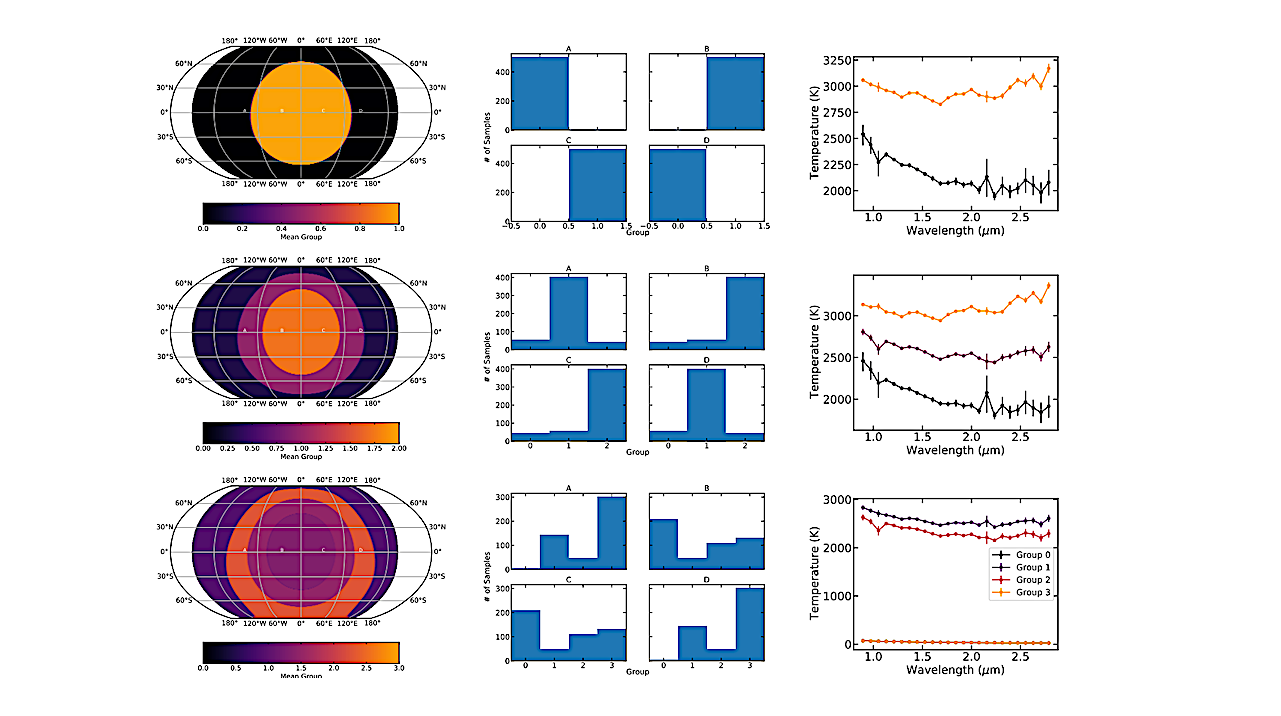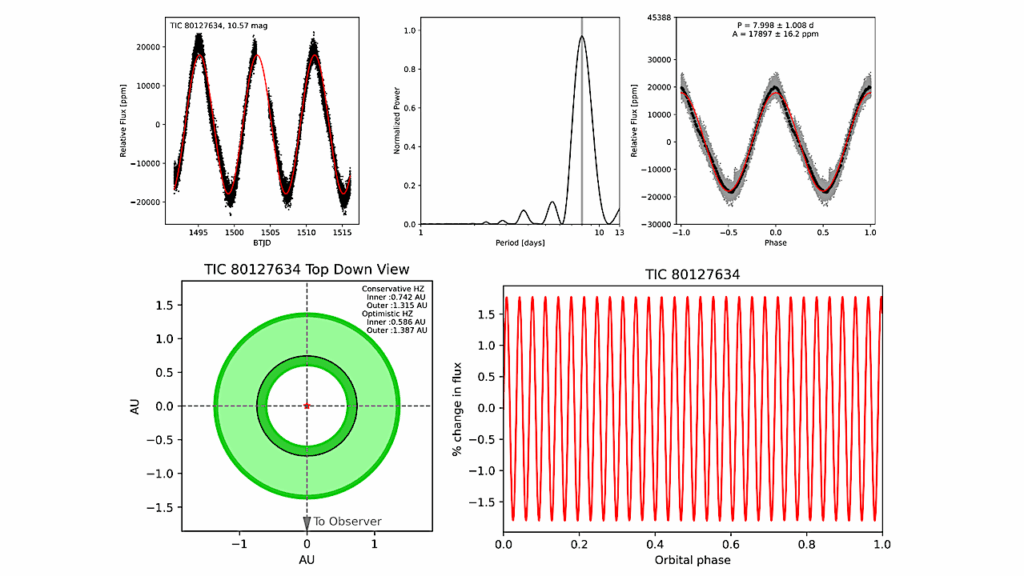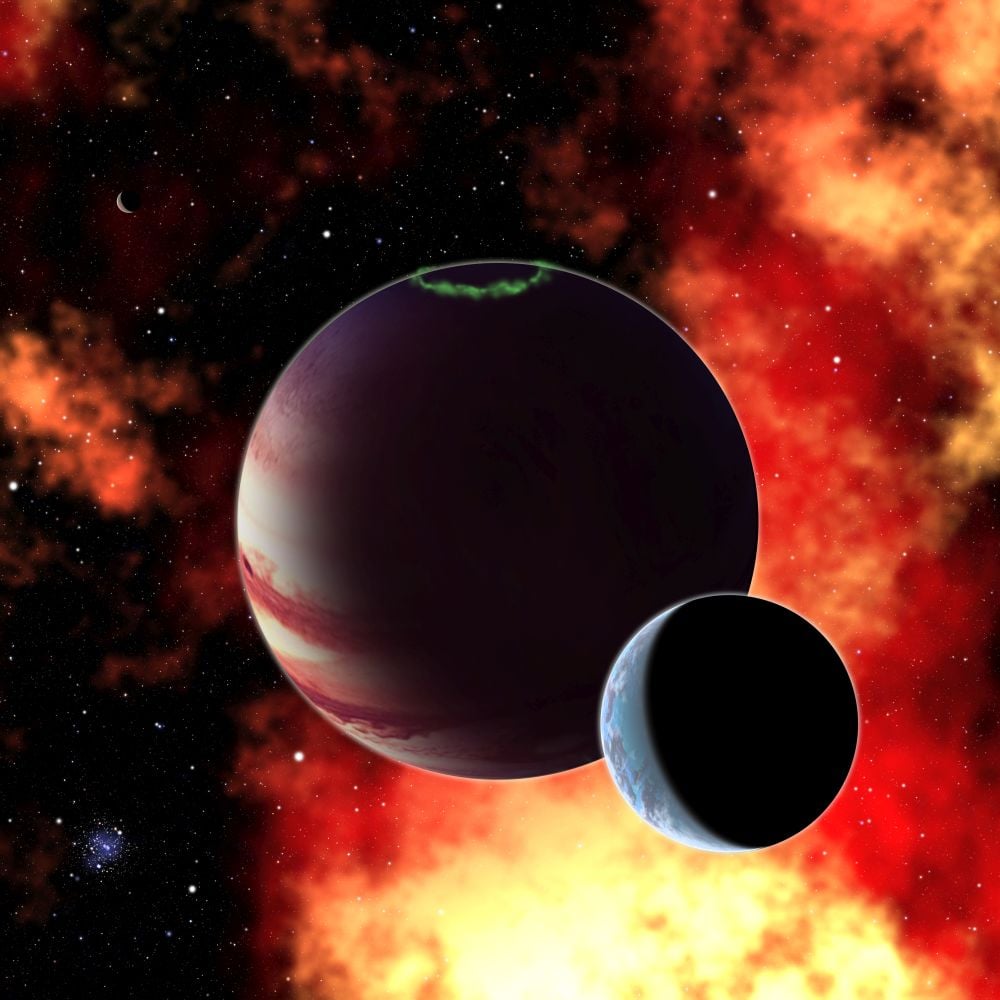Now Reading: Horizontal And Vertical Exoplanet Thermal Structure From A JWST Spectroscopic Eclipse Map
-
01
Horizontal And Vertical Exoplanet Thermal Structure From A JWST Spectroscopic Eclipse Map
Horizontal And Vertical Exoplanet Thermal Structure From A JWST Spectroscopic Eclipse Map


Mean group (left), histograms of grouping across several MCMC samples (middle), and resulting eigenspectra (right) for Eigenspectra mapping fits using 2 (top), 3 (middle), and 4 (bottom) groups. For each set of plots, histograms are labelled by letters which are overplotted on the map in the latitude/longitude position from which they are drawn (positions were chosen both near and far from group edges). Groups 2 and 1 here correspond to the hotspot and ring groups discussed in the text. For 3 groups, the map shows a clear division between groups and all of the points show ≥ 75% of points assigned to a single group. For 2 groups, there is a similarly clear division, and notably the hotspot and outer groups have quite similar spectra to the corresponding groups in the 3-group case. For 4 groups, the mean group map does not show a clear division of groups, and the histograms show that the same point is sorted into different groups depending on the posterior draw. Additionally, the resulting spectra are not distinct (the group 0 spectrum is identical to the group 4 spectrum, which is why it is not visible on the plot). Therefore, we used 3 groups for this fit. — astro-ph.EP
Highly-irradiated giant exoplanets known as “ultra-hot Jupiters” are anticipated to exhibit large variations of atmospheric temperature and chemistry as a function of longitude, latitude, and altitude.
Previous observations have hinted at these variations, but the existing data have been fundamentally restricted to probing hemisphere-integrated spectra, thereby providing only coarse information on atmospheric gradients.
Here we present a spectroscopic eclipse map of an extrasolar planet, resolving the atmosphere in multiple dimensions simultaneously. We analyze a secondary eclipse of the ultra-hot Jupiter WASP-18b observed with the NIRISS instrument on JWST. The mapping reveals weaker longitudinal temperature gradients than were predicted by theoretical models, indicating the importance of hydrogen dissociation and/or nightside clouds in shaping global thermal emission.
Additionally, we identify two thermally distinct regions of the planet’s atmosphere: a “hotspot” surrounding the substellar point and a “ring” near the dayside limbs. The hotspot region shows a strongly inverted thermal structure due to the presence of optical absorbers and a water abundance marginally lower than the hemispheric average, in accordance with theoretical predictions.
The ring region shows colder temperatures and poorly constrained chemical abundances. Similar future analyses will reveal three-dimensional thermal, chemical, and dynamical properties of a broad range of exoplanet atmospheres.
Ryan C. Challener, Megan Weiner Mansfield, Patricio E. Cubillos, Anjali A. A. Piette, Louis-Philippe Coulombe, Hayley Beltz, Jasmina Blecic, Emily Rauscher, Jacob L. Bean, Björn Benneke, Eliza M.-R. Kempton, Joseph Harrington, Thaddeus D. Komacek, Vivien Parmentier, S. L. Casewell, Nicolas Iro, Luigi Mancini, Matthew C. Nixon, Michael Radica, Maria E. Steinrueck, Luis Welbanks, Natalie M. Batalha, Claudio Caceres, Ian J.M. Crossfield, Nicolas Crouzet, Jean-Michel Désert, Karan Molaverdikhani, Nikolay K. Nikolov, Enric Palle, Benjamin V. Rackham, Everett Schlawin, David K. Sing, Kevin B. Stevenson, Xianyu Tan, Jake D. Turner, Xi Zhang
Comments: Published in Nature Astronomy. First two authors contributed equally
Subjects: Earth and Planetary Astrophysics (astro-ph.EP)
Cite as: arXiv:2510.24708 [astro-ph.EP] (or arXiv:2510.24708v1 [astro-ph.EP] for this version)
https://doi.org/10.48550/arXiv.2510.24708
Focus to learn more
Related DOI:
https://doi.org/10.1038/s41550-025-02666-9
Focus to learn more
Submission history
From: Megan Weiner Mansfield
[v1] Tue, 28 Oct 2025 17:56:26 UTC (9,744 KB)
https://arxiv.org/abs/2510.24708
Astrobiology,
Stay Informed With the Latest & Most Important News
Previous Post
Next Post
-
 012024 in Review: Highlights from NASA in Silicon Valley
012024 in Review: Highlights from NASA in Silicon Valley -
 02Panasonic Leica Summilux DG 15mm f/1.7 ASPH review
02Panasonic Leica Summilux DG 15mm f/1.7 ASPH review -
 03How New NASA, India Earth Satellite NISAR Will See Earth
03How New NASA, India Earth Satellite NISAR Will See Earth -
 04And Thus Begins A New Year For Life On Earth
04And Thus Begins A New Year For Life On Earth -
 05Astronomy Activation Ambassadors: A New Era
05Astronomy Activation Ambassadors: A New Era -
06SpaceX launch surge helps set new global launch record in 2024
-
 07Space Force plans new ‘Futures Command’ amid pressure to speed up modernization
07Space Force plans new ‘Futures Command’ amid pressure to speed up modernization




















